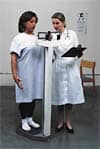Modern technology lets sleep medicine clinicians intervene before it’s too late.
When the first in-person appointment scheduled after therapy initiation is 30 or more days away, it can be hard for sleep physicians to monitor sleep apnea patients’ adherence to CPAP or positive airway pressure therapy and to intervene promptly during any minor complications. So patient difficulties—such as excessive leaks or mask discomfort—can lead to therapy discontinuation, often before patients even attend their first follow-up. But with advances in modern technology, physicians are now able to care for their patients faster and easier.
Telemonitoring—using software to monitor an individual’s sleep therapy—is being used by physicians to make any needed adjustments to resolve issues before they snowball into patient nonadherence.
“Telemonitoring allows us to leverage technology so we can direct our higher touch interventions to those patients who need it most,” says Dominic Munafo, MD, FABSM, chief medical officer at Sleep Data. “Sleep Data has created our own patient management platform that allows us to define exactly which parameters signal the need for an escalation to a coach,” he says. In 2016 in a study funded in part by ResMed, Munafo and co-investigators published data comparing a standard-of-care patient group that received calls on days 1, 7, 14, and 30 to a telehealth group that received automated electronic messages sparked by preset conditions. They found similar adherence between the two groups (83% adherence in telehealth group versus 73% in standard-of-care)—but the telehealth group required nearly 60% fewer coaching minutes. “[Telemonitoring] provides appropriately targeted interventions while reducing overall coaching minutes,” says Munafo. “The vast majority of calls to patients who are doing well can be eliminated with confidence.”
According to Munafo, by setting the parameters that determine the need for an intervention, physicians can identify specific issues. For example, he says, the presence of a continued high mask leak will prompt Sleep Data to call the patient to determine if a mask re-fit is necessary. “If a patient’s apnea hypopnea index (AHI) remains elevated, we can assess whether a higher pressure may be required or, perhaps, the high AHI is the result of continued or emergent central events. This may prompt questions to the patient or their [primary care] physician about narcotic pain medication or the presence of congestive heart failure,” he says. He stresses that this type of clinical information must be used in close consultation with the patient’s primary healthcare provider.
A study conducted at Saint-Pierre University Hospital in Brussels, Belgium, published in Sleep Medicine in 2017 specifically focused on links between early CPAP trouble-shooting prompted by telemonitoring versus instructing the standard-of-care patients to call as needed as well as attend a group session in 30 days and scheduled one-on-one doctor visits (the earliest visit being scheduled for 1.5 months after starting CPAP). Sleep lab staff were required to check the telemonitoring group’s CPAP data each Tuesday and Friday and initiate interventions if needed. “The [telemonitoring] system was the trigger for 39% of first technical interventions, such that a large part of first interventions were proactively generated by the nursing staff and not by the patients or during scheduled visits,” the authors state in the journal article. The delay was shortened by 18 days and, importantly, linked with improved compliance at 3 months. “In our series, we have shown that the majority of the patients (65% of patients in the [usual care] group and 78% in the [telemonitoring] group) required treatment adaptation early in the course of CPAP therapy. The support of these patients is therefore essential, and should be delivered as soon as possible in the course of CPAP,” the authors state. One hitch of the telemonitoring in this study is that these patients were more likely to skip their scheduled in-person visit at 3 months—perhaps because they felt they didn’t need any additional help.
Munafo says another challenge is that technology is rapidly changing, leaving some patients with incompatible systems. “Changes in supported modem technology have left us with hundreds if not thousands of patients with unsupported modems, and therefore no ability to utilize telemonitoring,” says Munafo. “Hopefully, future technology advances will be less disruptive, but as in all aspects of society, technology changes can be challenging.”
Despite potential challenges, Munafo thinks telemonitoring is a useful, effective approach for physicians who want to provide quality, timely care for their patients—who, he says, are commonly receptive to this type of care, adding that the overwhelming majority of patients who participate in Sleep Data’s telemonitoring program express an appreciation for the rapid and targeted support.
Munafo says the technology will progress and, in the future, be able to provide more individualized care. “The next generation of telemonitoring that Sleep Data is working on will be able to place patients into distinct phenotypes of CPAP usage that will have predictive value for ultimate CPAP success,” he says. “It will allow us to better define those for whom continued CPAP coaching is likely to result in benefit, and those who would be better served by switching to an alternate form of therapy such as a dental device.”
Dillon Stickle is associate editor of Sleep Review.





Telemonitoring and teleconference follow up care is the standard for mobile transportation workers like truck drivers.
Face to face interactions are a challenge unless you have semi truck capable parking at locations all over the US.